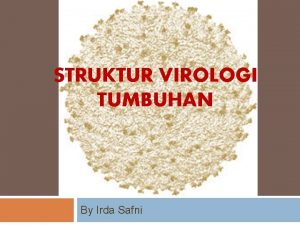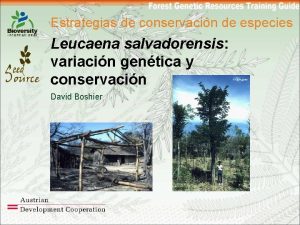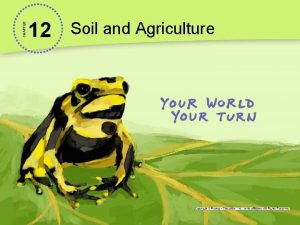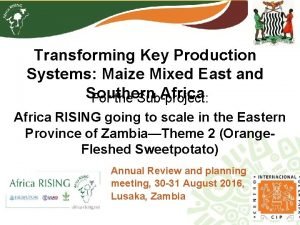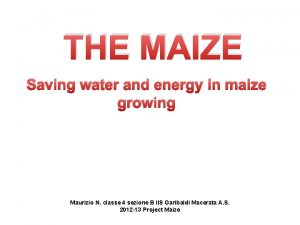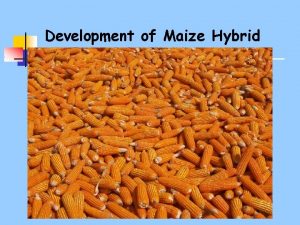Leucaena Maize Mosaic Virus and the Rise and
















- Slides: 16

Leucaena, Maize Mosaic Virus, and the Rise and Fall of the Classic Maya Civilization James L. Brewbaker Dept. Tropical Plant and Soil Science University of Hawaii W. Forest Genetics Association Merida, Yucatan, Mexico July 2000 12/20/2021

The Maya Civilization s Formative, Olmec 500 B. C. to 325 A. D. s Classic 325 to 925 A. D. Early Classic 325 to 625 A. D. Florescence 635 to 800 A. D. Abandonment 800 to 925 A. D. s Post-Classic, Toltec 975 to 1200 A. D. 12/20/2021

The MAYA -- A Remarkable Civilization -s s s Maya built a culture that survived 6 times as long as the Roman Empire Their cities outnumbered those of ancient Egypt They flourished while Europe suffered Dark Ages Their calendar was the equal of ours, dating back 0000 years Their math employed the concept of zero They predicted eclipses of sun and moon 12/20/2021

MAYA LANDS s 15° - 21° N, 88° - 92° W; 20 million ha s Atop a Giant Calcareous Plateau s p. H 6. 5 - 8. 0, High base status (Ca, K) s Fine soils -- Mollisols, Inceptisols s Tropical, Mean Annual Temp. 25° - 30°C s Rainfall; 1000 mm (north), 3000 mm (south) s South = 2 crops, Central = 1 -2 crops; North = 1 crop 12/20/2021

The Classic Maya lacked: s s Metal tools Beasts of burden (ruminants) The wheel Good sources of protein 12/20/2021

Intensive Maize Cropping Systems of the Classic Maya Civilization s s s Farms created out of high forests without metal tools Maize was the primary dietary energy source Yucatan Peninsula is calcareous, superb for year-round production of maize Much evidence for increasing intensity of cultivation Nal-Tel is excellent variety; 1. 5 t/ha on 20 kg N, to 5 t/ha on 150 kg Maya ate 2 kg maize/day/family (1 t/yr ~ 1 ha) 12/20/2021

N-fixing Trees and Maize Cropping Systems s s s Mimosoids abundant in Meso-America Leucaena species are found around most of the 1300 Maya ceremonial centers Leafdrop nitrogen avg. 300 kg/ha with rainfall >1500 mm/yr N recovered by maize avg. 25% from leafdrop Rapid regrowth upon coppicing (e. g. , canopy closure from randomly spaced trees in a year) Alley-farm systems more effective, “green manure” applied before/during maize growth 12/20/2021

Tikal, Guatemala Earliest Date = 292 A. D. ; Latest = 771 s Population; estimated 200, 000 s Major center of Maya (2 million people) s 60, 000 hectares s Tropical rain forest to 50 m s Five main pyramids, to 70 m s Two (+) maize crops per year s 12/20/2021

Civilizations; Some Premises Civilizations Rise and Fall on Their Stomachs s Classic Maya Civilization Rose due to High Maize Productivity s They Abandoned due to Failure to Sustain High Maize Productivity s But it only affected the 2 -crop Region s 12/20/2021

Collapsed Maize-based Civilizations s s Olmec, Vera Cruz (100 A. D. ) Teotihuacan, Mexico (650 A. D. ) Zapotec, Oaxaca (750 A. D. ) Maya, Yucatan & Guatemala (880 A. D. ) Anasazi, Southwest USA (1050 A. D. ) 12/20/2021

Why Abandon Good Maize Land? s Soil is lost, e. g. erosion on sloping land s s s Phosphorus is lost, e. g. , harvested off Nitrogen is lost Soil irreparably damaged, e. g. salinization Protracted flooding or drought Protracted maize diseases or pest damage 12/20/2021

Maize Mosaic Virus (MMV) Worldwide; Tropical; Lowlands only s Severe in continuous plantings (e. g. Hawaii) s Only hosts; Maize, Teosinte s Only vector; Peregrinus maidis planthopper s • Thrives only in lowland tropics • Thrives only on maize and teosinte • Virus is persistent, transmissible 30 days 12/20/2021

Resistance to MMV s s First described (1910) in Cuban Flint in Hawaii Shown to be monogenic, Mv locus (1967) • General resistance, non-racially specific • Heterozygotes intermediate; Mv BC’d into >100 inbreds • Mapped with RFLP to 3: 80 (1995) ¤ Mv confined to Caribbean races • Haitian Chandelle (25%), Coastal Tropical Flint (35%), Cuban Flint (20%), Caribbean (10%), Haitian Yellow (15%), St. Croix (40%), Tuson (35%) ¤ Mv essentially absent from 78 other tested races • Including all Races conceivably available to Classic Maya 12/20/2021 Early

Hypothesis No. 1 High-yield, sustainable maize production of the Classic Maya civilization was enabled by the use of Leucaena species Leucaena spp. are abundant around Maya ruins L. leucocephala, L. shannonii, L. collinsii s Maize + Leucaena = excellent agroforestry s They have similar environmental requirements: e. g. , Non-acid soils, High P, High Ca, Good drainage, Temperature/Moisture s Leucaena regrowth in a 3 -year fallow is ideal for restoration of maize soil fertility s Added benefits: food (pods), fuelwood, lumber 12/20/2021 s

Hypothesis No. 2 Collapse of Classic Maya (9 th century) was precipitated by introduction of Maize Mosaic Virus s s Classic Maya were limited to one major genetic source of maize, the variety Nal. Tel No Mexican or Meso-American varieties of maize were resistant to MMV All Caribbean varieties were tolerant to MMV; the Arawak grew maize in Haiti/Dom. Rep Virus-borne leafhoppers easily introduced from Caribbean islands (e. g. , by hurricanes) 12/20/2021

CONCLUSIONS s s s Classic Maya civilization “rose” to great heights due to excellent yields of yearround maize in mimosoid-rich lowland tropics Classic Maya civilization “collapsed” due to persistent failure of maize crops in 9 th century Maize mosaic virus is most likely cause of failure; Nal-Tel highly susceptible Virus restricted to year-round production areas in lowlands Maya retreated to north (Yucatan) and to south (Guatemala highlands), escaping virus 12/20/2021
 Causal agent of tobacco mosaic virus
Causal agent of tobacco mosaic virus Booking
Booking Icosahedral adalah
Icosahedral adalah Brome mosaic virus
Brome mosaic virus Cauliflower mosaic virus
Cauliflower mosaic virus Leucaena salvadorensis
Leucaena salvadorensis Variacin
Variacin Tricky dick
Tricky dick Rise and rise again until lambs become lions
Rise and rise again until lambs become lions Raise and rise again until lambs become lions
Raise and rise again until lambs become lions A union b example
A union b example A cereal formulated from maize sorghum and cottonseed flour
A cereal formulated from maize sorghum and cottonseed flour Thank you for listening
Thank you for listening Maize gdb
Maize gdb Possible transgenic maize in oaxaca mexico
Possible transgenic maize in oaxaca mexico Maize gdb
Maize gdb Maize
Maize


